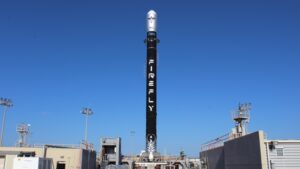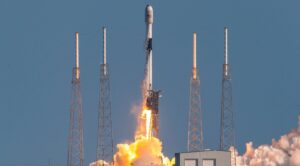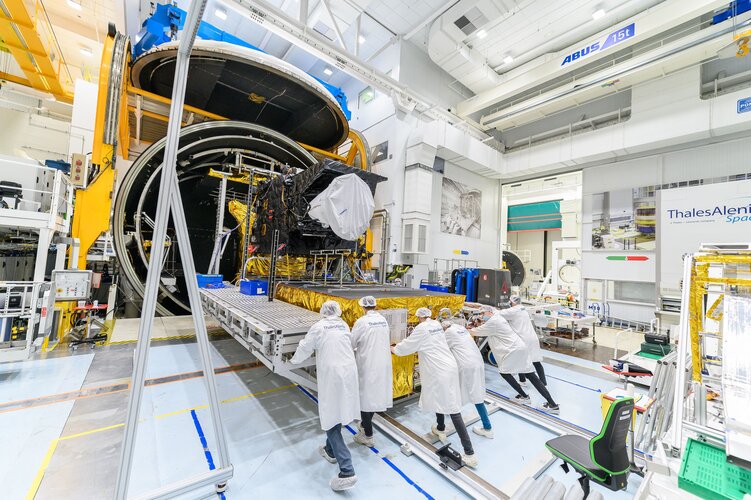Spaceflight Inc and Astrocast Extend Launch Contract
Wednesday, 23 March 2022 10:38 Spaceflight Inc., the leading global launch services provider, has announced an extended multi-launch agreement (MLA) with long-time customer, Internet of Things (IoT) constellation developer, Astrocast. This agreement will add two missions to accommodate Astrocast's fast-growing IoT constellation which helps track assets in some of the world's most remote regions.
In February of 2020, Ast
Spaceflight Inc., the leading global launch services provider, has announced an extended multi-launch agreement (MLA) with long-time customer, Internet of Things (IoT) constellation developer, Astrocast. This agreement will add two missions to accommodate Astrocast's fast-growing IoT constellation which helps track assets in some of the world's most remote regions.
In February of 2020, Ast SES to Accelerate Access to C-Band Spectrum to support rapid deployment of 5G
Wednesday, 23 March 2022 10:38 SES, the leader in global content connectivity solutions, announced an agreement with Verizon Communications to expand the US-based mobile carrier's access to a portion of the C-band (3700-3800 MHz) in important regions across the US earlier than the relocation deadlines set out in the U.S. Federal Communication Commission's (FCC) C-Band Report and Order.
SES has already completed its Phas
SES, the leader in global content connectivity solutions, announced an agreement with Verizon Communications to expand the US-based mobile carrier's access to a portion of the C-band (3700-3800 MHz) in important regions across the US earlier than the relocation deadlines set out in the U.S. Federal Communication Commission's (FCC) C-Band Report and Order.
SES has already completed its Phas Russia hypersonic missile 'not a game changer' in Ukraine: US
Wednesday, 23 March 2022 10:38 Russia's claim it used a hypersonic missile in Ukraine was a way to reclaim war momentum, but the next-generation weaponry has not proved to be a "game changer," the Pentagon's chief said Sunday.
Moscow has said it has fired two hypersonic missiles in Ukraine, and while US Defense Secretary Lloyd Austin would not "confirm or dispute" whether Russia used such weapons, he warned that President
Russia's claim it used a hypersonic missile in Ukraine was a way to reclaim war momentum, but the next-generation weaponry has not proved to be a "game changer," the Pentagon's chief said Sunday.
Moscow has said it has fired two hypersonic missiles in Ukraine, and while US Defense Secretary Lloyd Austin would not "confirm or dispute" whether Russia used such weapons, he warned that President Australia launches Space Command to counter China's ambitions
Wednesday, 23 March 2022 10:38 Australia's government on Tuesday launched "Space Command", a new defence agency with echoes of the United States' Space Force that has been tasked with securing the country's place in an "already contested" cosmos.
Defence Minister Peter Dutton said the new defence arm would be modest to start with, though he gave no detailed staffing or budget figures.
In a speech to the Australian Air
Australia's government on Tuesday launched "Space Command", a new defence agency with echoes of the United States' Space Force that has been tasked with securing the country's place in an "already contested" cosmos.
Defence Minister Peter Dutton said the new defence arm would be modest to start with, though he gave no detailed staffing or budget figures.
In a speech to the Australian Air Mars helicopter Ingenuity completes 22nd flight
Wednesday, 23 March 2022 10:38 NASA's Mars helicopter Ingenuity completed its 22nd flight over the weekend, the space agency announced.
"The trip lasted 101.4 seconds and Ingenuity got up to 33 feet in the air," NASA's Jet Propulsion Laboratory said in a tweet Monday. "The team is planning another flight perhaps as early as later this week."
During its first 21 flights, Ingenuity flew a total of 15,247 feet an
NASA's Mars helicopter Ingenuity completed its 22nd flight over the weekend, the space agency announced.
"The trip lasted 101.4 seconds and Ingenuity got up to 33 feet in the air," NASA's Jet Propulsion Laboratory said in a tweet Monday. "The team is planning another flight perhaps as early as later this week."
During its first 21 flights, Ingenuity flew a total of 15,247 feet an Drilling into Mars with Lasers
Wednesday, 23 March 2022 10:38 Perseverance is adding a pop of color to Mars' regular repertoire: purple. The color palette of Mars' surface is one of muted hues. Burnt orange tones reflect the iron-bearing minerals that have rusted under an oxidizing atmosphere while soft greys characterize the un-rusted parent rock.
However, over the past year we have seen prominent patches of purple peppered atop the rocks. The patch
Perseverance is adding a pop of color to Mars' regular repertoire: purple. The color palette of Mars' surface is one of muted hues. Burnt orange tones reflect the iron-bearing minerals that have rusted under an oxidizing atmosphere while soft greys characterize the un-rusted parent rock.
However, over the past year we have seen prominent patches of purple peppered atop the rocks. The patch Sol 3421: Close Encounter with a "Gator"
Wednesday, 23 March 2022 10:38 Curiosity is investigating the different surface expressions of the Greenheugh pediment, and the weekend drive put the rover right next to some "gator-back terrain" - some evenly spaced ridges with a blocky expression, as seen in the above Navcam image. Today's one sol plan is focused on a close encounter with one of these ridges through contact science and remote sensing.
The plans starts
Curiosity is investigating the different surface expressions of the Greenheugh pediment, and the weekend drive put the rover right next to some "gator-back terrain" - some evenly spaced ridges with a blocky expression, as seen in the above Navcam image. Today's one sol plan is focused on a close encounter with one of these ridges through contact science and remote sensing.
The plans starts Ryugu be a remnant of an extinct comet
Wednesday, 23 March 2022 10:38 Asteroids hold many clues about the formation and evolution of planets and their satellites. Understanding their history can, therefore, reveal much about our solar system. While observations made from a distance using electromagnetic waves and telescopes are useful, analyzing samples retrieved from asteroids can yield much more detail about their characteristics and how they may have formed. An
Asteroids hold many clues about the formation and evolution of planets and their satellites. Understanding their history can, therefore, reveal much about our solar system. While observations made from a distance using electromagnetic waves and telescopes are useful, analyzing samples retrieved from asteroids can yield much more detail about their characteristics and how they may have formed. An Characteristics of Apophis, the asteroid that will approach Earth in 2029
Wednesday, 23 March 2022 10:38 The study, in which the Universidad Carlos III de Madrid (UC3M) and the Universidad Estatal Paulista Julio de Mesquita Filho (Julio de Mesquita Filho Paulista State University) (UNESP) of Brazil are participating, analyses the surface and dynamics of Apophis, an asteroid that will pass close to Earth in 2029.
The Apophis asteroid was discovered in 2004 and has been monitored since then due
The study, in which the Universidad Carlos III de Madrid (UC3M) and the Universidad Estatal Paulista Julio de Mesquita Filho (Julio de Mesquita Filho Paulista State University) (UNESP) of Brazil are participating, analyses the surface and dynamics of Apophis, an asteroid that will pass close to Earth in 2029.
The Apophis asteroid was discovered in 2004 and has been monitored since then due NASA confirms more than 5,000 planets outside the solar system
Wednesday, 23 March 2022 10:38 The total number of confirmed planets in the universe ticked past 5,000 this week with the addition of 65 exoplanets, NASA says.
The space agency said the confirmed planets are just a small fraction of the billions of planets the Milky Way likely holds. That number only increases when considering galaxies outside our own.
The newly added exoplanets - worlds that exist outside ou
The total number of confirmed planets in the universe ticked past 5,000 this week with the addition of 65 exoplanets, NASA says.
The space agency said the confirmed planets are just a small fraction of the billions of planets the Milky Way likely holds. That number only increases when considering galaxies outside our own.
The newly added exoplanets - worlds that exist outside ou Firefly raises $75 million as it prepares for second launch
Wednesday, 23 March 2022 10:17
Launch vehicle developer Firefly Aerospace has raised $75 million in a new funding round as the company, now under new ownership, prepares for a second launch of its Alpha rocket this spring.
The post Firefly raises $75 million as it prepares for second launch appeared first on SpaceNews.
Blaming inflation, SpaceX raises Starlink and launch prices
Wednesday, 23 March 2022 09:26
SpaceX has raised prices for both its Starlink broadband service and for dedicated and rideshare launches, in some cases by up to 20%, citing inflation.
The post Blaming inflation, SpaceX raises Starlink and launch prices appeared first on SpaceNews.
MTG-I weather satellite passes tests in preparation for liftoff
Wednesday, 23 March 2022 07:30
With extreme weather events threatening to be more frequent and more severe as the climate crisis takes grip, it’s never been more important to have fast and accurate forecasts. ESA and Eumetsat are working hard to ensure that there will be a constant stream of weather data from space for the next decades and that these data will arrive faster and be more accurate compared to what we have today. It is therefore fitting that on World Meteorological Day, ESA can be assured that the first of the next generation weather satellites, Meteosat Third Generation
Former Momentus executive Fred Kennedy to lead startup focused on nuclear-powered rocket engines
Tuesday, 22 March 2022 23:24
Fred Kennedy, a former Pentagon official and veteran space executive, announced March 22 he is leading a new startup to commercialize nuclear thermal rocket propulsion.
The post Former Momentus executive Fred Kennedy to lead startup focused on nuclear-powered rocket engines appeared first on SpaceNews.
Satellite supply chains coming under increasing scrutiny
Tuesday, 22 March 2022 20:41
Changes in the geopolitical landscape following Russia’s war in Ukraine are pushing space companies to tighten international supply chains amid a renewed focus on security.
The post Satellite supply chains coming under increasing scrutiny appeared first on SpaceNews.

